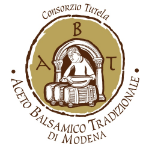Properties and use
-
-
Is everything that tastes bad good for you?
-
Therapeutic properties and the name “Balsamic”
-
It improves the mood
-
What tastes good can also be good for you
-
Sublime aromas and flavours
-
According to an old countryside saying from Modena, “Everything that tastes bad is good for you”. But would we be right to lend any credence to that notion today? The modern-day chemical-pharmacological industry has succeeded in making treatments and medicines largely palatable but, at least in one sector, it is nature itself that has created an extraordinary remedy with a sublime taste: Traditional Balsamic Vinegar of Modena. This is nothing new; on the contrary it lends further weight to the presumed reasons why the name “Balsamic” was given to this product which comes from one of the oldest Modenese traditions. Its medicinal properties are confirmed by numerous studies on the product and its raw materials, carried out by universities and research institutes worldwide.
For Traditional Balsamic, which in the past was the preserve of aristocratic or in any case rich families, numerous ancient documents bear witness to how the noble product was used in the past for its healing properties. It was probably only after the Second World War, with the advent of chemically synthesized medicinal treatments, that vinegar was demoted in most people’s minds to merely a food product. Recent studies, on the other hand, testify to the reliability of historical documents regarding the medicinal use of “balsamic” by illustrious figures like Lucretia Borgia, Isabella d’Este, Francesco IV, Duke of Modena and even the composer Gioacchino Rossini. These studies confirm the beneficial effects of polyphenols and, in particular, resveratrol (in which our grapes are especially rich), linked to significant antioxidant, antiprotease and antimutagenic (chemical and physical) and vasoprotective (pharmacological) activities, and found to be helpful in ophthalmological (clinical) conditions. These many different components – which range from phenolic acids and flavonoids to hydrolysable and condensed tannins, as well as anthocyanins – have been recognised as powerful antioxidants which work by capturing free radicals in the blood and inhibiting lipid peroxidation. These properties are known to inhibit the endothelial damage associated with all inflammatory processes. Indeed, in various in-vitro biochemical models, flavan-3.4-diol, one of the basic units of condensed tannins, has been shown to prevent pathological states related to ischaemia. Procyanidins have been shown to exert vascular protective effects thanks to their antioxidant and anti-peroxidative properties, along with their antiprotease and anti-glucosidase activity. It is interesting to note how they appear to promote better nourishment of the structures of the retina thanks to their powerful, protective microvascular effect. And we mustn’t neglect to mention the well-known benefits of the vitamins, minerals and sugars which Traditional Balsamic obtains straight from the grape must. These are key ingredients in food preparations for specific uses (athletes’ diets) and food supplements. Vitamins naturally present in grapes include vitamin C, up to 1 per cent of the edible part, but also beta carotene, thiamine, riboflavin and niacin, in quantities that increase with product ageing. Grape juice contains up to 65 per cent fructose, the sugar with the lowest calorific value and normally also widely used in the commercial sector for the production of food products for diabetics, athletes and students. Last but not least, the product is also a valuable source of minerals, especially potassium salts, which are essential for good muscle function and myocardial contraction.
After all these considerations, we can certainly add that Traditional Balsamic Vinegar, which is rich in all of the properties mentioned above, also offers incredibly delicious and irresistible flavours and aromas that are highly conducive to good spirits. And what might we say of the fact that old producers (but also today’s younger generation of producers) claim that simply being in their vinegar lofts surrounded by barrels is enough to lift their mood and restore their inner peace? In any case, we have no authority to hail this product - like they did in the past - as an extraordinary condiment with great healing and medicinal properties. Only doctors and researchers can make such claims, but the great universal encyclopaedia of the Internet offers no end of information in that regard.
In Modena and Reggio Emilia, however, we can take great pride in our special vinegar, as it disproves the old cliché that “everything that tastes bad is good for you”, proving instead that “what tastes good can also be good for you”. To appreciate exactly how good it is, trying adding a few drops to the simplest of dishes or ingredients, to boiled meat or vegetables, roasts or crudités, or to fruit and ice cream; it is guaranteed to deliver a jubilation of sublime aromas and flavours, fit for a King
